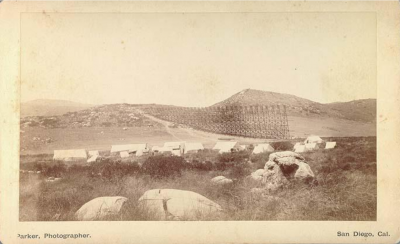 Courtesy of Cabrillo National Monument
Courtesy of Cabrillo National Monument
Photo: Dignitaries including California’s Governor rode the flume across East County, from Lake Cuyamaca to Lake Murray.
February 23, 2023 (San Diego) -- 134 years ago, the San Diego Flume opened. Today, the word flume is often used to describe a type of theme park ride in which users get splashed while riding in a wooden roller coaster. While such a thing would be ahead of its time in the 1880s, the San Diego Flume was far more significant, because it provided something essential to the residents of the small but growing city of San Diego than any thrill ride could: abundant water.
The Flume’s construction began in 1886 with the goal of bringing a reliable and plentiful water supply to the residents of the growing city and county of San Diego. The Flume project dammed the San Diego River's waters at the bottom of the Cuyamaca Mountains and then through a 35 mile complex of wooden chutes, trestles, and tunnels delivered it to a reservoir in La Mesa. From there, water was conveyed to places across San Diego where residents could reliably irrigate their farms and gardens and enjoy plentiful drinking water.
Nine million board feet of redwood, $900,000 in capital, and around 800 mules and horses were necessary to build the 315 trestles and eight tunnels that comprised The Flume. The Flume was such an important achievement in this arid region that numerous dignitaries, including California's governor, the appropriately named Robert W. Waterman, led a procession of flat-bottomed boats down the flume to celebrate its opening. This activity, known as "shooting The Flume" became something of a viral trend in 1890’s San Diego County and tourists and residents would ride the flume as a form of pleasure boating.
 The Flume was rendered superfluous by the construction of the El Capitan Reservoir in 1935 and it has largely disappeared. However, at least one portion, the Historic Flume Trail in Lakeside where you can see remnant tunnels, a pumphouse, and other infrastructure from The Flume, remains. Though The Flume’s creation is largely forgotten today, the celebration that its opening garnered demonstrates how long water supplies have been critically important to people in San Diego County.
The Flume was rendered superfluous by the construction of the El Capitan Reservoir in 1935 and it has largely disappeared. However, at least one portion, the Historic Flume Trail in Lakeside where you can see remnant tunnels, a pumphouse, and other infrastructure from The Flume, remains. Though The Flume’s creation is largely forgotten today, the celebration that its opening garnered demonstrates how long water supplies have been critically important to people in San Diego County.











Recent comments